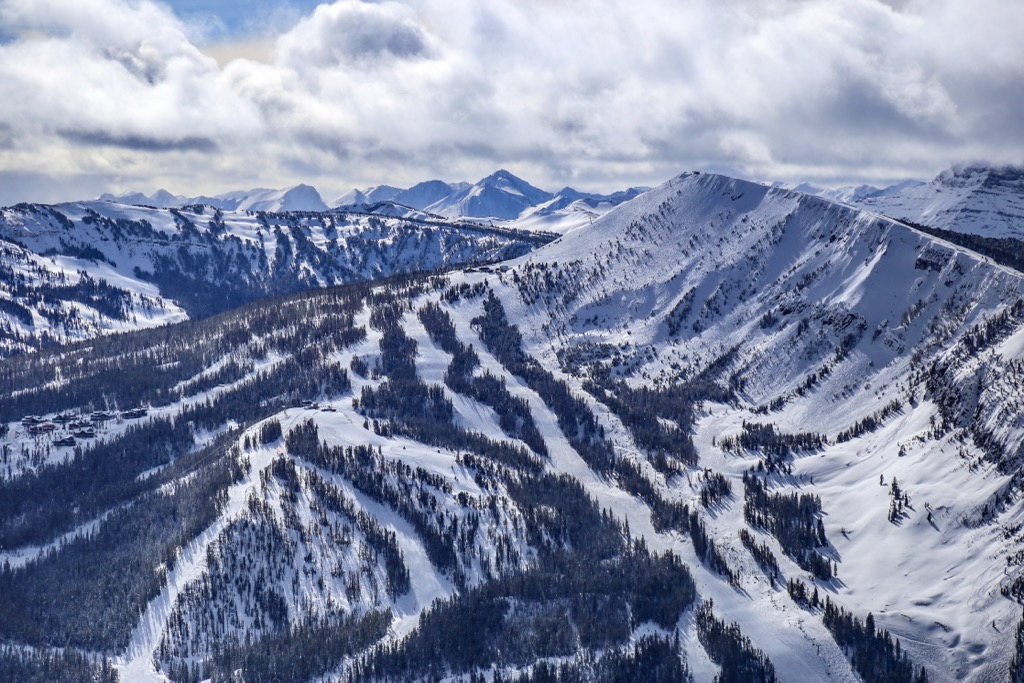Get PeakVisor App
Sign In
Search by GPS coordinates
- Latitude
- ° ' ''
- Longitude
- ° ' ''
- Units of Length
- Temperature

Yes
Cancel
Share ×

Scan the QR code and open PeakVisor on your phone
❤ Wishlist ×
Choose
Delete
Big Sky Resort’s name suggests a vast, majestic landscape where peaks and valleys stretch infinitely into the horizon. Then reality is not far off. Situated all around the striking Lone Mountain, the scale of Big Sky is daunting. It is the second-largest ski resort in the United States, located on the border of Gallatin County and Madison County, Montana. Big Sky features 5,850 skiable acres (2,367 hectares), accessed by 38 lifts, including the legendary tram to Lone Peak. Skiers will experience 4,350 feet (1,326 m) in vertical drop from summit to base. Big Sky features plenty of terrain for all skiers of all levels: beginner, intermediate, and expert skiers will be at home here. There is even some technical ski-mountaineering and extreme skiing. The resort’s season lasts from mid-late November until late April.
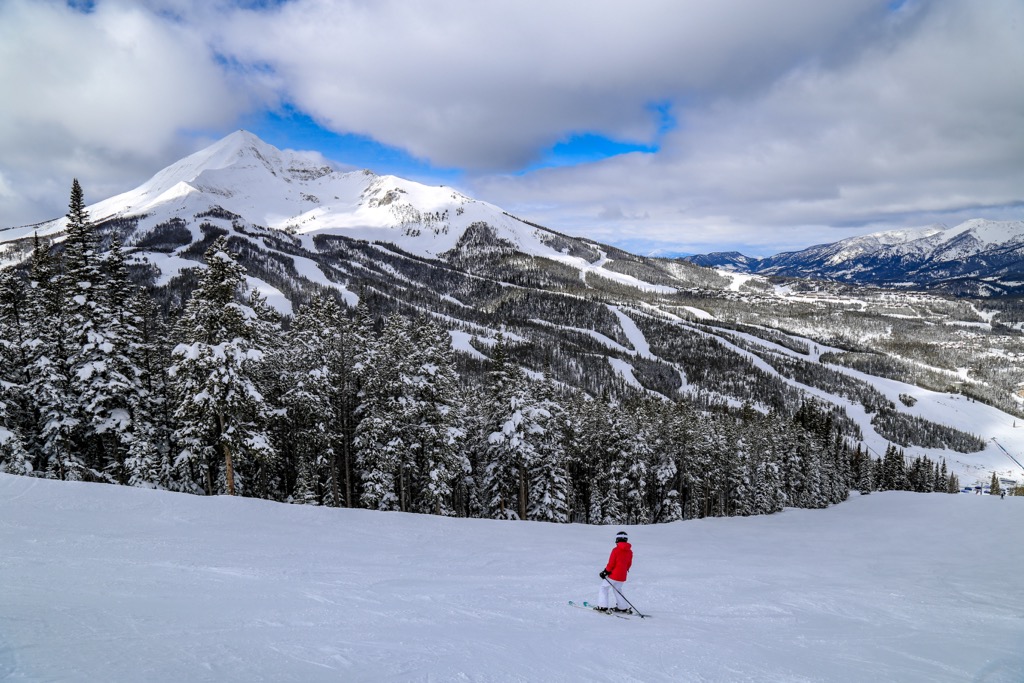
Big Sky Resort is located around all aspects of Lone Mountain in the Madison Range of southern Montana. Lone Mountain itself is very impressive to behold. It towers over the surrounding valley, rising 5,132 feet (1,564 m) above the valley to its west. On its eastern flank sits Big Sky resort and the Gallatin River. Directly to the resort’s west and south are several more peaks and unnamed valleys. Fan Mountain and Pioneer Mountain are easy to see from the summit and make for picturesque views. Further to the west is the town of Ennis and the Madison River Valley. Big Sky is near Bozeman, MT, about a half-hour drive to the northwest.
Big Sky is also reasonably close to Yellowstone National Park, an international destination and one of the most famous parks in the world.

If you’re coming to Big Sky resort, you’ll probably be driving from Bozeman, Montana.
Bozeman has the nearest international airport to Big Sky (Bozeman International Airport). BIA has daily, direct flights to and from many locations in the United States and is the easiest way for out-of-state visitors to get to Big Sky. Drive west and south from Bozeman along U.S. Highway 191 for about a half-hour, and you will arrive at Big Sky.
As you crawl up the access road and catch a first glance at the resort, you realize how expansive it is. Just parking your car seems daunting. Fortunately, there is plenty of free parking and a free shuttle to get you to and from the lifts. For first-timers, I recommend heading to the Mountain Village free parking area, which includes Lone Peak, Cinnamon, Cedar, Gallatin, Levinski, and Ramshorn Lots. From the Mountain Village, you will have easy access to ticketing and the central hub of lifts at the mountain. You can also head to the Madison Base Lot for easy access to Moonlight Basin, including the Six Shooter lift.
Because of Big Sky’s size, it can be challenging to navigate. When you get your day pass or ticket, pick up a map. There are a few main lifts that access different parts of the mountain. These are Southern Comfort, Thunder Wolf, Swift Current, Challenger, Six Shooter, and Shedhorn. You can get to any part of the resort using these lifts, including the backside.
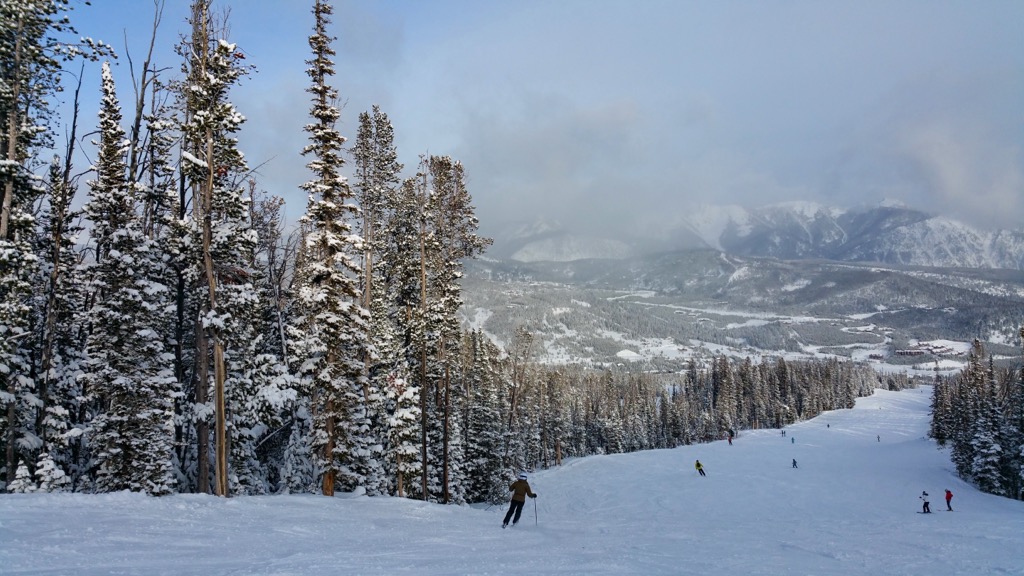
Southern Comfort is the main access route from Spirit Mountain, which marks Big Sky’s far southern corner, to Andesite Mountain. Thunder Wolf climbs the far side of Andesite Mountain, the middle peak of the resort. Ramcharger is the main access point from the Mountain Village to Spirit Mountain and Andesite Mountain, the entire southern region of Big Sky.
Swift Current grants access to the backside, the Shedhorn lift, and the upper bowl (with access to the summit). From the top of Swift Current, you can head to the bottom of Challenger, which ends at the Headwater’s base. From there, you can traverse into Moonlight Basin. Six Shooter is the only return from Moonlight Basin to the frontside Mountain Village.
Snow falls in Montana for about six months of the year. A low sun-angle, bitter-cold continental airmasses, and plenty of powder ensure the skiing at Big Sky lasts from the end of November through April.
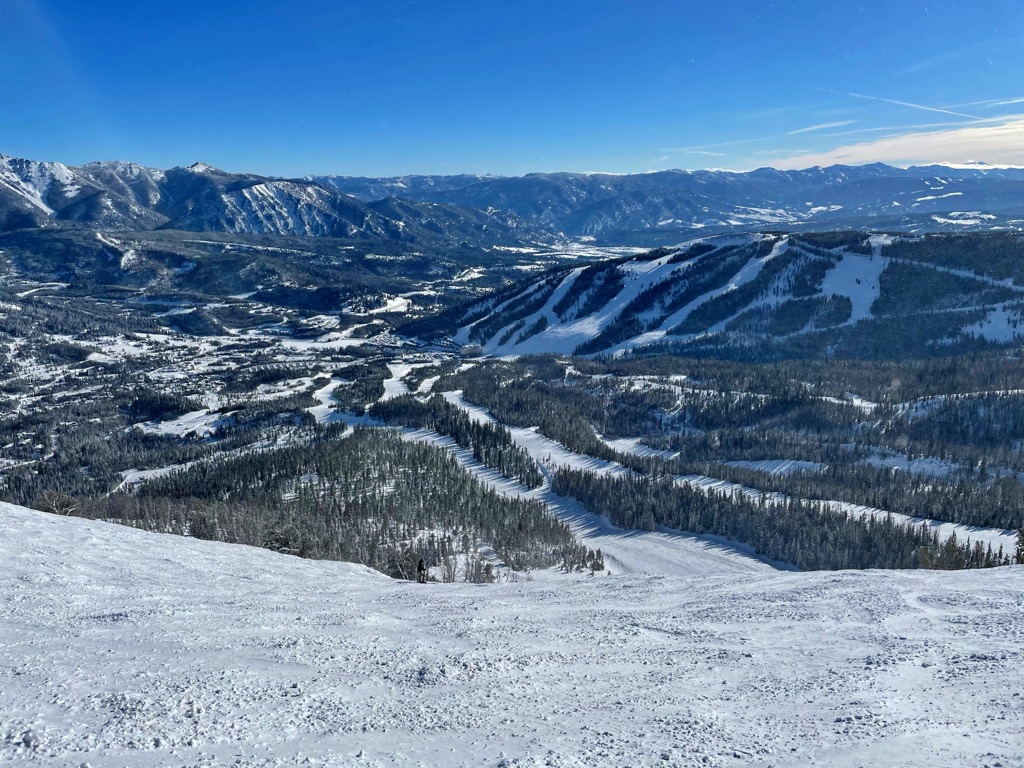
Temperatures drop off steeply in October, setting the stage for winter. But snowfall usually doesn’t begin in the Gallatin Range until November. A few dustings will happen here and there, typically not until mid-month.
December and March are Big Sky’s snowiest months, averaging 16 and 13 days of snowfall, respectively. By the end of December, the mountain typically has a solid base. There are sometimes freak snowstorms in the early season, like in 2018 when Big Sky had 76 inches (193 cm) of snow in November.
In January, things typically cool off. Snowfall slows, and temperatures hit the season low, with lows averaging just above 0°F (-18°C). Remember, Montana is a frigid climate. From December until the end of January, temperatures rarely rise above freezing (32°F or 0°C). The cold helps to protect the snowpack from freeze-thaw cycles.
Cold temperatures also give Montana some of the highest snow ratios in the United States. Snow in Montana regularly falls at or above a 12:1 ratio, meaning that one inch of water in precip produces at least 12 inches (30 cm) of snow. The ratio can often reach 15:1 or higher, conjuring the fabled “cold smoke” powder for which Montana is known. This incredibly light, airy snow is uniquely enjoyable to ski.
As the winter solstice ebbs and winter becomes marginally warmer, the air can hold more moisture. The snow begins to fly again, and the snowpack continues to build. February averages 53 inches (135 cm) of snow, and March averages another 56 inches (142 cm). At Big Sky, the best conditions usually happen later in the season. March temperatures are much friendlier, and conditions are as playful as they ever get with a solid base.
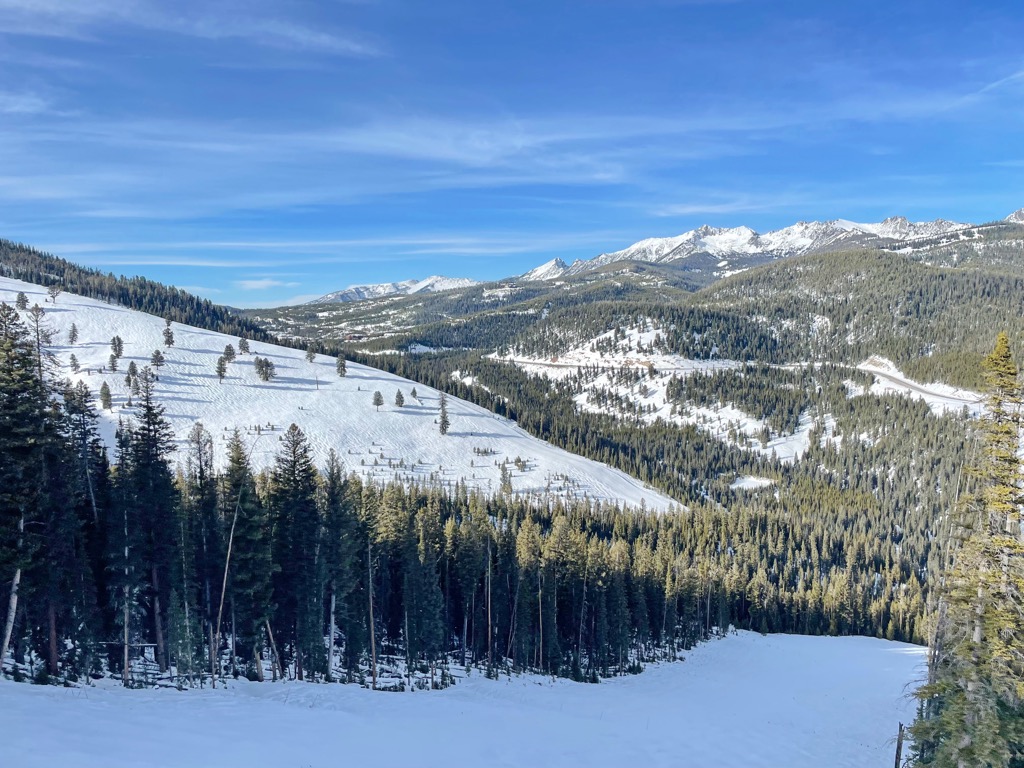
Rolling into April, storms keep coming. April averages 36 inches (91 cm) of snow, and sunny skies take over. Daily highs can rise above 50°F (10°C). Bluebird powder and corn skiing days with long afternoons make for top-notch riding. When it’s all said and done, Big Sky averages a whopping 400 inches (1016 cm) average snowfall annually.
But the rising temps cut through the season’s snowpack quickly. By the end of May, almost all the snow on Lone Mountain will be gone, and summer will be fully back in control.
It’s nearly impossible to explain how to navigate Big Sky in words. Take a look at the resort map for more information. Naturally, the best way to learn the ins and outs of this massive hill is to spend a day skiing around the mountain.
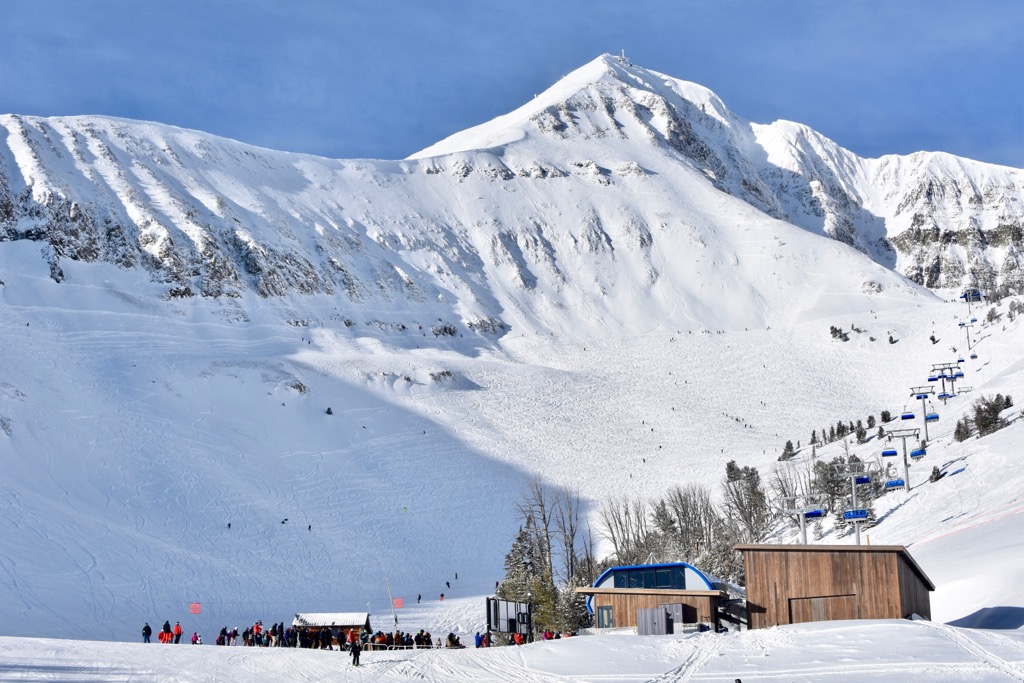
Big Sky is shaped a bit like a quarter pipe. It’s steep at the top and progressively becomes more mellow as you approach the base. The peak’s upper reaches consist of either treacherous, technical chute skiing or steep, open faces that collect powder like a dream. The lower elevation slopes are much less steep and are covered in dense forests. Big Sky’s glades are very thick, often too thick to ski. However, there are some fantastic spots to ski trees here. You just need to know where to look.
As you progress further down, the slopes become easier for beginners to navigate. Crisscrossing over the mountain's lower reaches are hundreds of named runs, all groomed to perfection daily. There is a wealth of freestyle terrain parks to explore for freestyle skiers.
Big Sky covers three mountains with three significant aspects. Luckily, there is one landmark you can use to navigate from just about anywhere at Big Sky: the ominous, looming Lone Mountain.
Lone Mountain is a behemoth. Its summit reaches 11,167 ft (3,404 m), making it the fifth tallest in the Madison Range. Compared to its neighbors, it stands out for its prominence (2,722 ft, 830 m). Lone Mountain stands apart from other mountains in the range and is visible across vast distances.
The Headwaters side of the mountain is a vast area serviced by just two lifts. You'll have to ride two lifts to get to the far right drainage below the Headwaters Cirque. The runs back down are long and never play out the same way twice. The trees are sparse here, and powder caches will lie in wait, sometimes for a week or more after a storm.
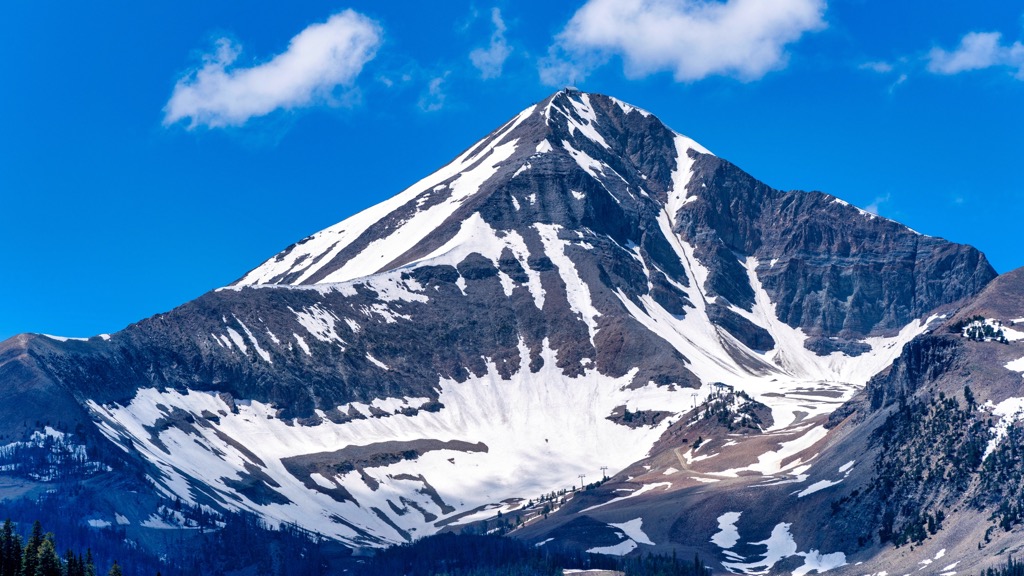
But there are still two other entire mountains in bounds at Big Sky. Looking left from the Mountain Village, you’ll see Andesite Mountain (8,800 ft, 2,682 m). It’s much less prominent than Lone Mountain, with sloping flanks covered in trees.
From the base of Southern Comfort Lift, you can access Spirit Mountain (8,028 ft, 2,447 m). Spirit is the smallest peak at Big Sky. It’s a far-flung corner of the resort with a few lifts and delightful, easy terrain.
Spirit Mountain’s primary purpose is to service the far southeastern part of the mountain village. There’s a lot of development on this side of the Village, and many visitors start and end their days here.
Beginning a mountain tour, you could start at Spirit Mountain and sweep your way across, one lift at a time. You would traverse the hunched profile of Andesite Mountain and the convex ridges and basins of Lone Mountain. You would have just enough time to turn around and traverse the entire way across the three mountains to your chalet.
Slopes

Ski lifts
Other features and services
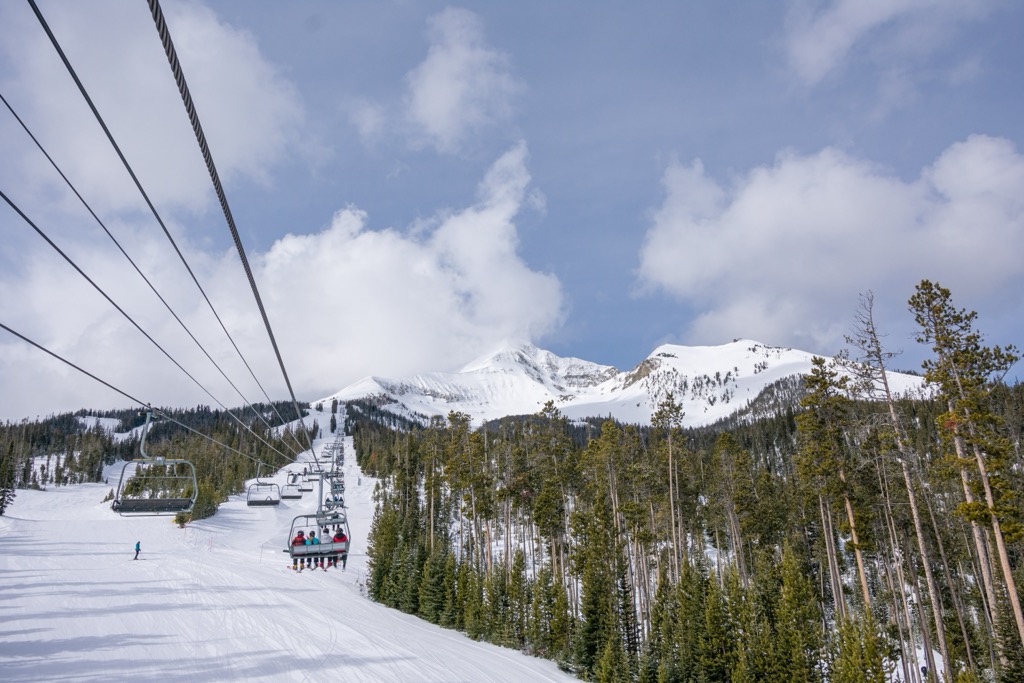
Big Sky has terrain to suit skiers of all ability levels and tastes. If you want to enjoy yourself on mellow groomers, you have a buffet of options from which to choose. If you want to ski trees, there are considerable forests to explore. If you want to strap on crampons and ski some of the most intense, technical lift-access terrain in the United States, you’ve come to the right place.
However, Big Sky is so big that navigation is tricky at first. Rifling through maps to find the lift you’re looking for is a mess, and ending up at the bottom of the wrong mountain after the last chair is no fun. So here’s what you need to know to avoid getting lost.
For description, let’s assume you arrive at the resort’s main Mountain Village area first. This is the central hub of the resort. You’re just a couple of chairlifts from any part of the mountain.
The most obvious option is to head to the top, so let’s do that. Hopping on the Swift Current lift will take you to the rim of the Upper Bowl and give you a great vantage point for the rest of the resort. Looker’s right is the Headwaters Cirque, a hard left gets you to the back side, and straight ahead is the Upper Bowl. You can also access the Upper Bowl by taking Explorer lift to Challenger and then skiing down.
Once in the Upper Bowl, you can ride to the summit of Lone Mountain. First, take Powder Seeker lift. From the top of Powder Seeker, you’ll be at the base of the Lone Peak Tram. The tram only operates when weather permits, less often than you imagine. But if you come for an extended period, it will probably be open at some point. Other times it’s open for weeks on end.
From the top of the Lone Peak Tram, you’ll have one of the best views in Montana. But again, that’s entirely weather-dependent. Sometimes the summit stays completely socked in for weeks, with very little visibility.
Skiers hunting after America’s great lines wouldn’t be satisfied without taking a stab at the Big Couloir. It’s the most famous run at Big Sky, and for good reason. It was the first-ever run to be rated a triple black diamond. Since then, it’s been a sought-after prize for skiers everywhere.
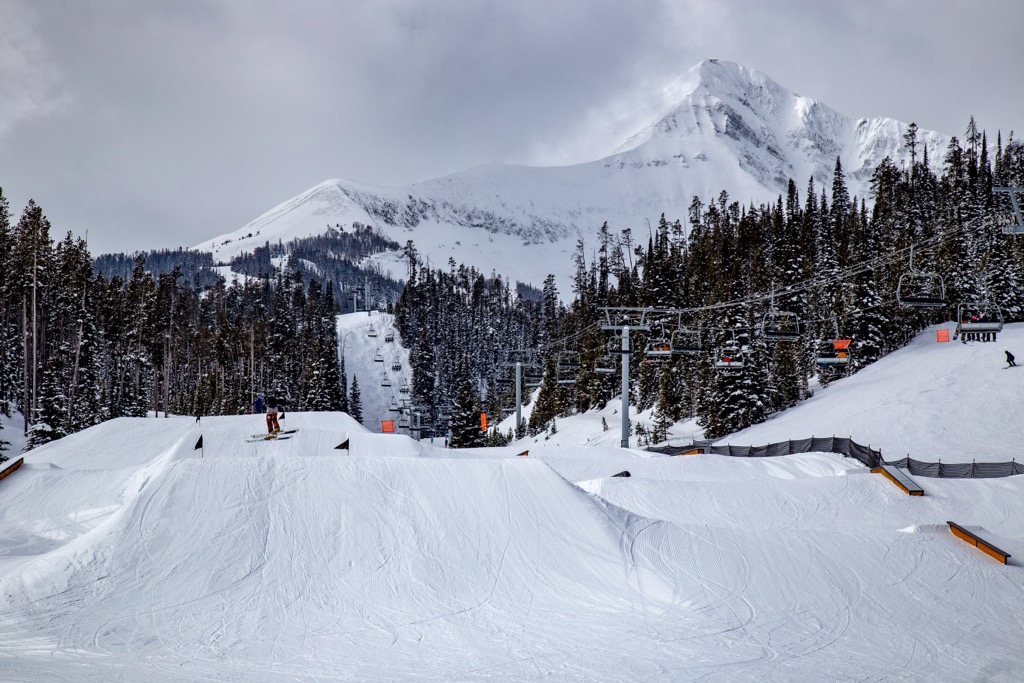
Lone Mountain’s summit is a barren, snowy cap that endures intense, freezing winds during the winter. The windswept snow forms monstrous cornices that overlook the mountain’s most recognizable feature: the Big Couloir. This chute rapidly descends 1,400 ft (427 m) into the mountain’s rounded basin, the Upper Bowl.
Below the summit, the slopes are subdivided by spurred ridges. The snowfields gathered around the summit give way to steep, rocky cirques. The mountain’s cirques look almost like parapets, vertical lines of rock separated by narrow tongues of snow. They form parallel-running chutes, including some of the mountain’s most technical terrain.
Moving down from the summit, you can ski into the south face, the Big Couloir, which leads down into Lone Mountain’s gigantic bowl, or down the North Summit Snowfield, which opens into the Headwaters. The Upper Bowl is ringed in on all sides by massive cliffs pocked by skiable chutes. The mountain’s most hardcore skiers spend their time here. The Upper Bowl is a natural marvel just to observe, let alone ski.
The other option for descending from the Upper Bowl is to head between the two imposing walls and back toward the mountain village. This is one of the most high-traffic areas at the resort. The mountain’s main freestyle park is located here, along with a lot of easy groomer skiing.
If you head south, you’ll find yourself poised above the Dictator Chutes, the least technical option for getting off the summit (although Castro’s Chute is still rated a triple black diamond). Further left is the Liberty Bowl, an open face just steep enough to be fun for experts.
The south face itself is expansive but easy to navigate. Around a third of the way down, you’ll run into a tight forest of pine trees. Runs and narrow gullies crosscut this forest as they meander toward the base. Steep to mellow is the general character of the back side of Big Sky. The runs begin with open, snowy expanses and end in a forest of coniferous trees. These forests are fun to ski through but can be very tight.
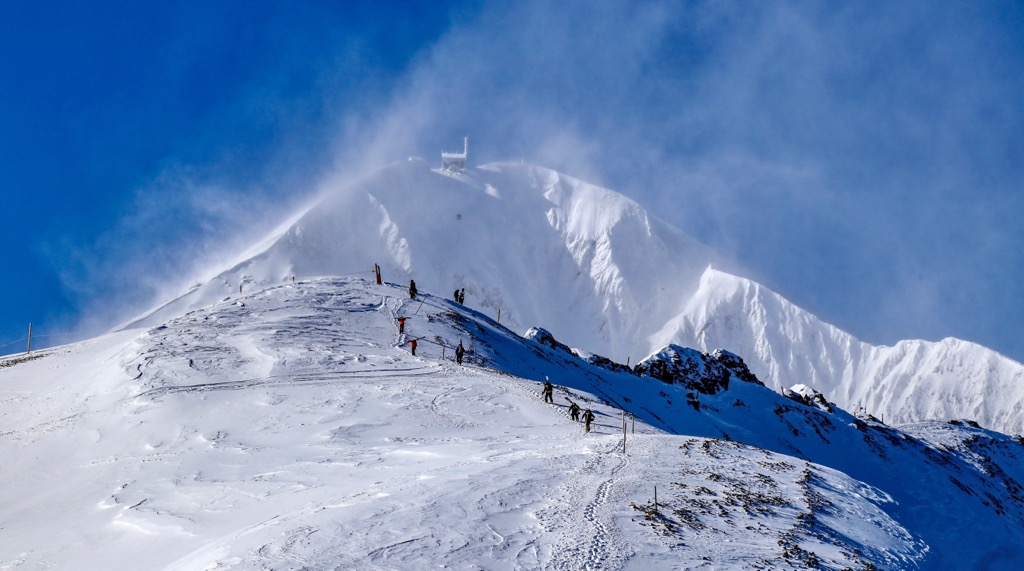
On the far looker’s left of the south side, Kircher’s Cliffs is an impressive, rocky band that you can sometimes ski through, depending on the snowpack. Another cliff band, Dirtbag Wall, is on the extreme right of the south side. Dirtbag Wall separates the south face from the Upper Bowl.
A cliff band called the A-Z Chutes is opposite the Upper Bowl from Dirtbag Wall. This area is accessible only by bootpack and requires strong skiing skills and mountaineering know-how. The far side of the A-Z Chutes is yet another massive cirque called the Headwaters. The Headwaters spans two different drainages. It looks almost like books on a shelf, with incredibly technical chutes interspersed between the covers.
The base of the Headwaters Cirque is just above the treeline. Below that, it’s just beautiful, steep skiing. Some of the resort’s best tree skiing resides on this side of the peak.
To ski the Big, you must stop by the ski patrol shack on top of Lone Mountain and register. Ski patrol will check to ensure you’re wearing a beacon and have a buddy. Then they’ll give you a time window and send you on your way.
Buckle up. The Big Couloir is steep, deep, and technical. But, if we’re being honest, it’s not the steepest, the deepest, or the most technical skiing at Big Sky. That title goes to either the Headwaters or A-Z Chutes, which I’ll discuss more in the next section.
Heading back down from the summit, you have a few options. You can either hang right, traversing around the Upper Bowl to the back side, or hang left, traversing below the Headwaters into Moonlight Basin.
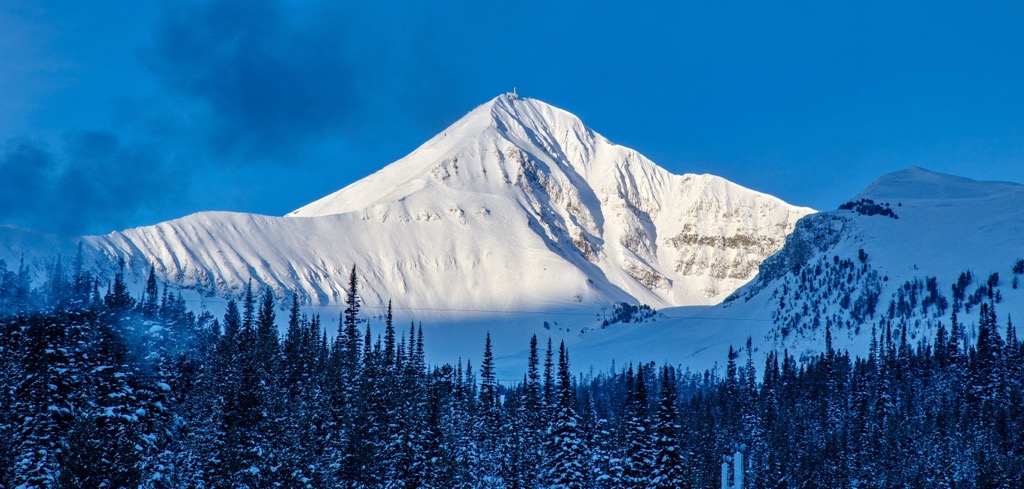
The backside is home to two of the mountain’s longest lifts, Shedhorn and Dakota. This face of the mountain is covered in trees, crisscrossed by narrow gullies. It’s a great spot for sunny days later in the season or bluebird powder days when the line for the tram gets crazy. You can also ski directly off the summit onto the backside by either the Dictator Chutes or Liberty Bowl, which are great options for experienced skiers.
Heading into the Moonlight area, you have a ton of options. This side of the resort is a sprawling expanse that would take a long time to explore thoroughly. You can also get to Moonlight Basin from the Moonlight Base area by hopping on either Challenger or Iron Horse lift through Pony Express.
Once you cross the ridge into Moonlight, you have a long run left to the base area. Runs on this side of the mountain cover huge distances, so the main lift back up from the bottom is a high-speed six-pack called Six Shooter.
Where you should ski in Moonlight Basin depends on your ability level. Experts will want to check out the Headwaters lift for steep, rocky chutes. If you’re into tree skiing, I highly recommend traversing under the Headwaters to Lone Tree lift. This short ride with amazing views of the Headwaters Cirque brings you to the top of the absolute best tree skiing at Big Sky. There are also some spicy cliff bands directly under the lift.
Intermediates will want to pick their way through Moonlight Basin to the bottom of Six Shooter. There are lots of short off-piste sections to explore and short detours through the trees that will help you increase your confidence and give you a taste of the more intense skiing at Big Sky. Intermediates will also enjoy taking Lone Tree lift and traversing to the looker’s right, over another ridge. This section of the mountain is full of moderate slopes and is usually devoid of crowds. It’s a prime spot to stretch your legs and explore if you’re just getting used to skiing off-piste.
Beginners will want to stick mainly underneath the Six Shooter lift. There are many well-groomed runs on this side of the mountain, but many are on the steep side. If you’re a newbie just starting to explore the resort, stick to the looker’s left side of Moonlight Basin and enjoy the views.
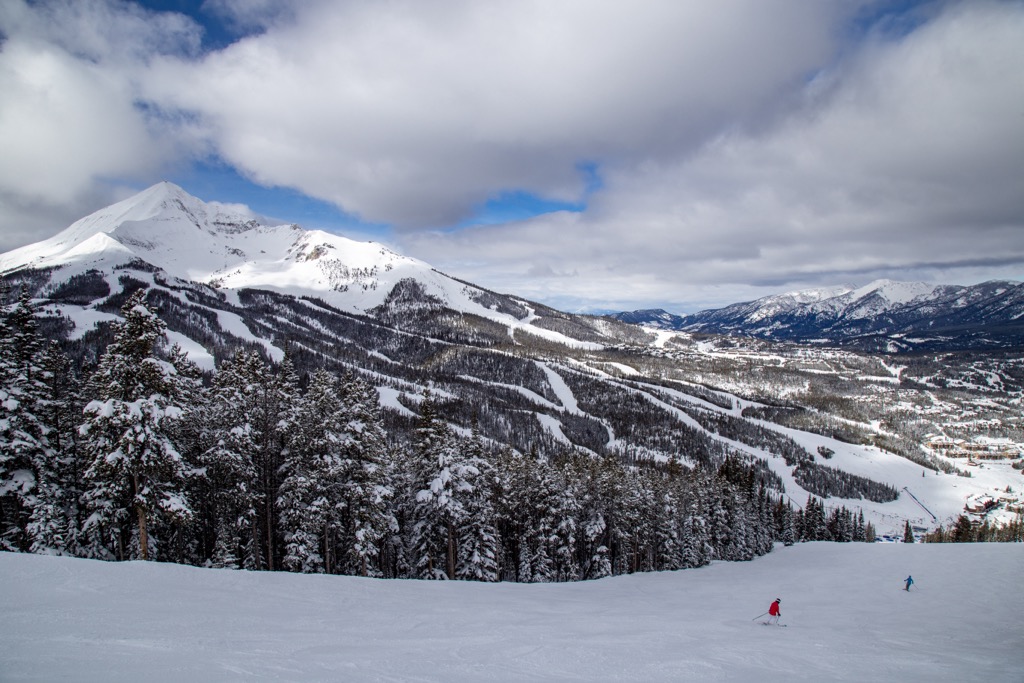
There is also usually a freestyle terrain park that runs the length of the Six Shooter lift, often featuring a natural progression from small to larger features. This area is accessible by either Six Shooter or Derringer Lifts. To get back out of Moonlight Basin, hop on Six Shooter and traverse looker’s left back around the ridge. This will get you to the base area.
In a nutshell, that’s the entirety of Lone Mountain. Your other option from the base area is to hop on Ramcharger, probably the most high-tech ski lift on earth. It’s an 8-seater with a climate-controlled bubble and heated seats. Even if you don’t plan to ski this side of the resort, I highly recommend taking a trip up Ramcharger just to see what it’s like.
From the top of Ramcharger, you’ll find yourself on Andesite Mountain, looking west at Lone Mountain. Skiing back down to the Base Area from the top of Andesite is a lot of fun, and there is some surprisingly technical off-piste skiing here. You can also head south, below the Thunder Wolf lift. This side of Andesite mountain is playful. It’s a wide-open area with a very moderate pitch, great for beginners and intermediates who want to get used to going fast while skiing parallel.
From the bottom of Thunder Wolf, you can traverse to the looker’s left to the base of Lone Moose. This lift services a short pitch of steep, densely forested terrain perfect for when the mountain is crowded.
You can drop onto the south face of Andesite Mountain from the top of Lone Moose, Thunder Wolf, or even Ramcharger. The Southern Comfort lift services this side of Andesite, and it’s one of the most under-appreciated areas at Big Sky. The relaxed, mellow slope is sparsely covered in young pine trees. But on powder days, when the more technical terrain is crowded or tracked out, this is an ideal spot to hang out and score endless powder turns. It’s also an excellent place for beginners to learn to ski powder snow.
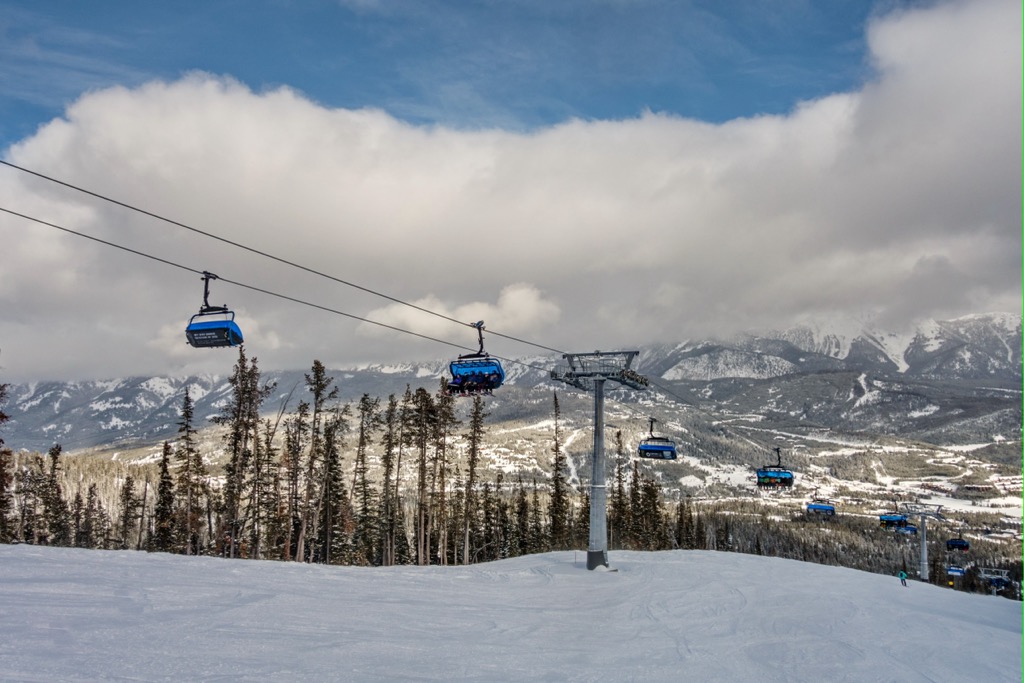
At the base of Southern Comfort, you can go back up the lift to the top of Andesite Mountain or take Sacagawea lift to the top of Spirit Mountain.
Spirit is some of the most relaxed terrain at Big Sky and is a perfect spot for beginners to learn. From the top of Spirit Mountain, you can head back to the Sacagawea lift or trend further left to the bottom of the Lewis and Clark lift. The Southern Comfort face features even more gradual slopes. The skiing is very relaxed in this corner of the resort. If you’re a beginner looking to escape crowds and enjoy some wide-open space, this is the spot to visit.
We’ve covered all of the traditional chairlifts (and most of the skiable terrain) at Big Sky. But Big Sky’s landscape constantly changes, and the resort seems to add or upgrade lifts every year. There is a smattering of surface lifts and rope tows that will also help you get around the resort.
Big Sky Resort takes backcountry skiing to another level. Not only can you backcountry ski here, but you can also ski mountaineer in-bounds. For folks learning the art of ski mountaineering, it’s hugely helpful to do it in avalanche conditions controlled by a team of patrollers.
Granted, that doesn’t mean avalanche danger is zero. There’s always some risk of triggering an avalanche or having a cornice drop on you. But regarding avalanche safety, Big Sky is about as good as it gets for ski mountaineering.
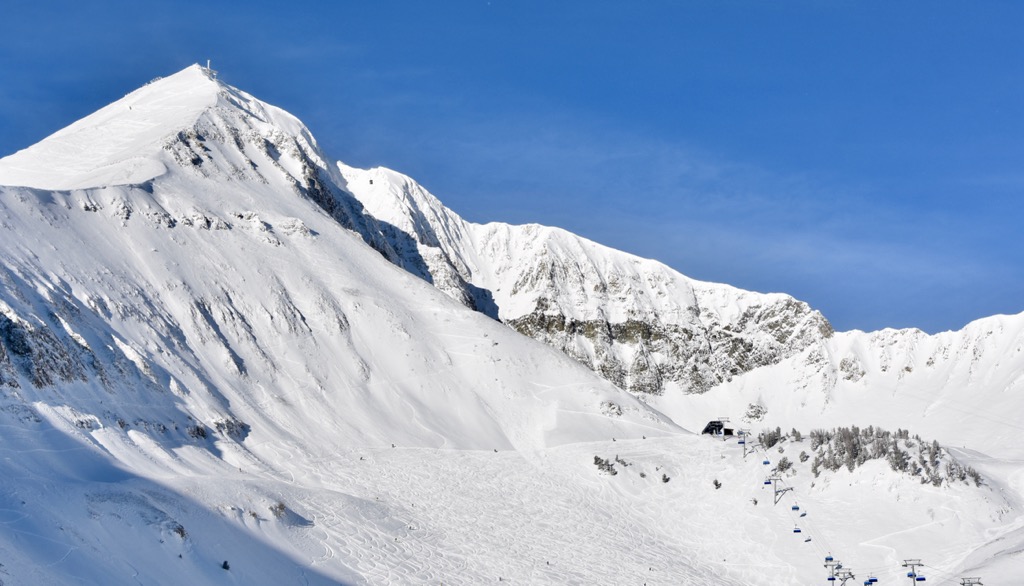
Looking at the map of the resort, you’ll notice quite a few areas are above lift access. Specifically, I’m talking about the northern wall of the Upper Bowl. The inside of this wall is the A-Z Chutes, and the outside (facing north) is the Headwaters Cirque. The extreme right of the Headwaters is accessible by the Tram. However, most of the cirque and the A-Z Chutes are accessible by uphill travel only.
So, how do you ski the A-Z Chutes and Headwaters? For starters, read up. This area is hazardous and is only sometimes open to uphill travel. If you poach a line when it’s closed, you risk your ski pass and your life. But if the conditions are right, you can take Challenger or Headwaters lift to the shoulder of the ridge. Beyond this point is an access gate. If it’s not open, don’t risk it. But on green light days, you’ll find an open gate. It’s time to bootpack to your desired chute, clip in, and drop.
It’s never that simple, though. The further you go along the Headwaters ridge, the dicier things get. You’ll likely need crampons and an ice axe to complete the climb. Yes, I said climb. Depending on the snowpack, wind conditions, and which route you’re going for, you may have to do some mixed climbing to get to your line. As you traverse, be very mindful of where you are. There are a ton of chutes along this ridge, and it’s easy to get turned around.
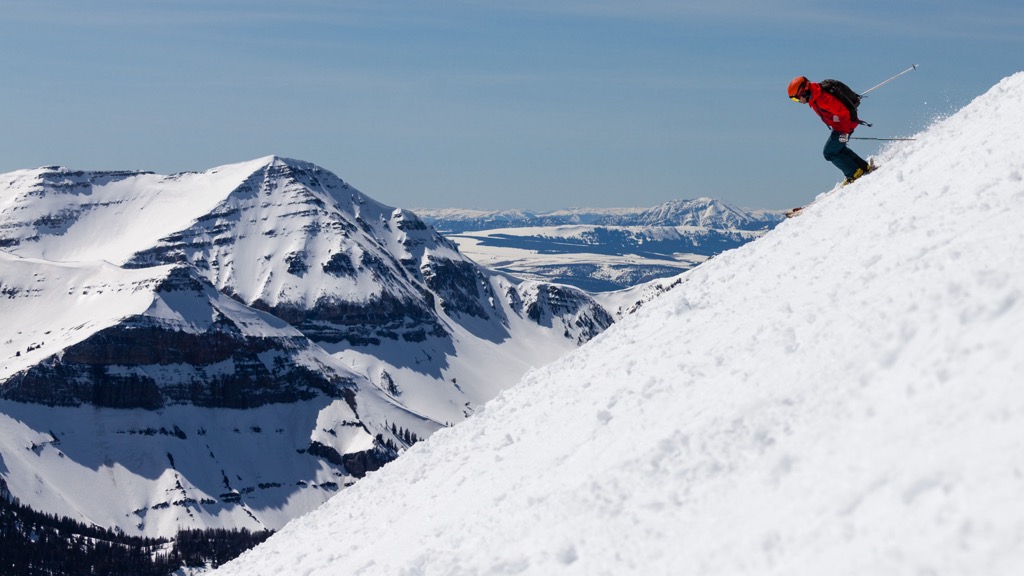
As you traverse, you’ll pass some very technical objectives. Class 4, 5, and 6 are all exciting lines, forming tight chutes that terminate at a cliff. Skiers cut to the looker’s right and meet up with Whitetail to finish the line. The Three Forks are also very intense. There’s usually a fixed handline set up to help you traverse some of the rocks before the entrance. These three are probably the longest lines on the Headwaters Cirque.
Further out is the Trident, which requires the most technical approach. These chutes are prized lines for those with guts and a lot of know-how and are seldom skied.
On the flip side of the ridge are the A-Z Chutes. These lines are very straight, very steep, and very narrow. Expect to do some jump turns, especially at the top.
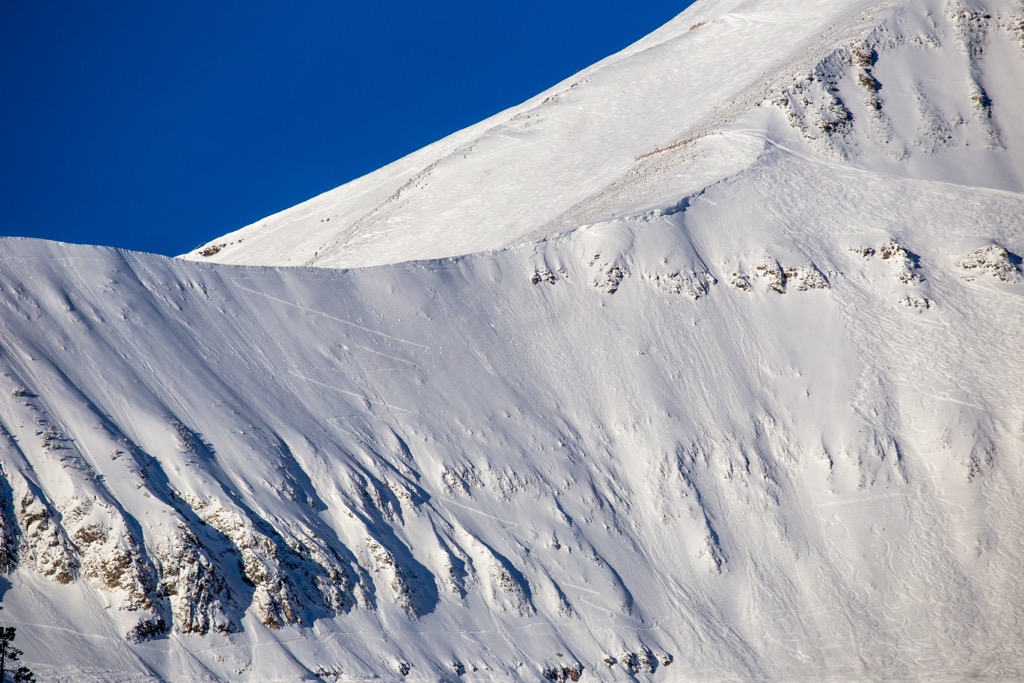
Another area you can get to on foot is the Yeti Traverse, which sits above the Dakota Lift on the back side. This traverse grants access to the Dictator Chutes, which you can access via the Tram. Bootpacking uphill from Dakota Chute is a little less involved. From the top of the Dakota lift, look to the left. There should already be a boot pack in place.
If it’s open, you can proceed, following the looker’s left side of Liberty Bowl to the summit of Lone Peak. Where you drop from here is your choice. Heading back down the backside is a popular option. You can pick any of the Dictator Chutes, which are fun and a little easier than the stuff you’ll find along the Headwaters.
Another option is to skirt to the right around the mountain. You’ll see the entrances to six very steep, thrilling chutes from the Yeti Traverse to the Gullies Traverse. These are the Gullies 1-6. This terrain often goes unnoticed by powder chasers. The lines are short but intense.

Skiing Big Sky is a coveted experience, reflected in the ticket and pass pricing. Day and season passes vary from year to year. Single-day passes start at $125 if you buy in advance online and go up to $238 for tickets purchased same-day.
Season passes are always cheaper to buy long before the season starts. If you purchase a basic season pass (no blackout dates, no tram access) at the beginning of the season, you’ll spend $1,699.
Luckily, there are some cheaper ways to ski Big Sky. Big Sky is part of the IKON Pass, which is considerably more affordable than a Big Sky season pass. It’s also part of the Mountain Collective.
Another trick for more affordable passes at Big Sky is to stay at the resort and plan for later in the season. If you’re in resort lodging April 9-23, you’ll get passes as low as $179.
The resort also has a military discount (40% off) and various discounts for booking with different concessionaires around the resort.
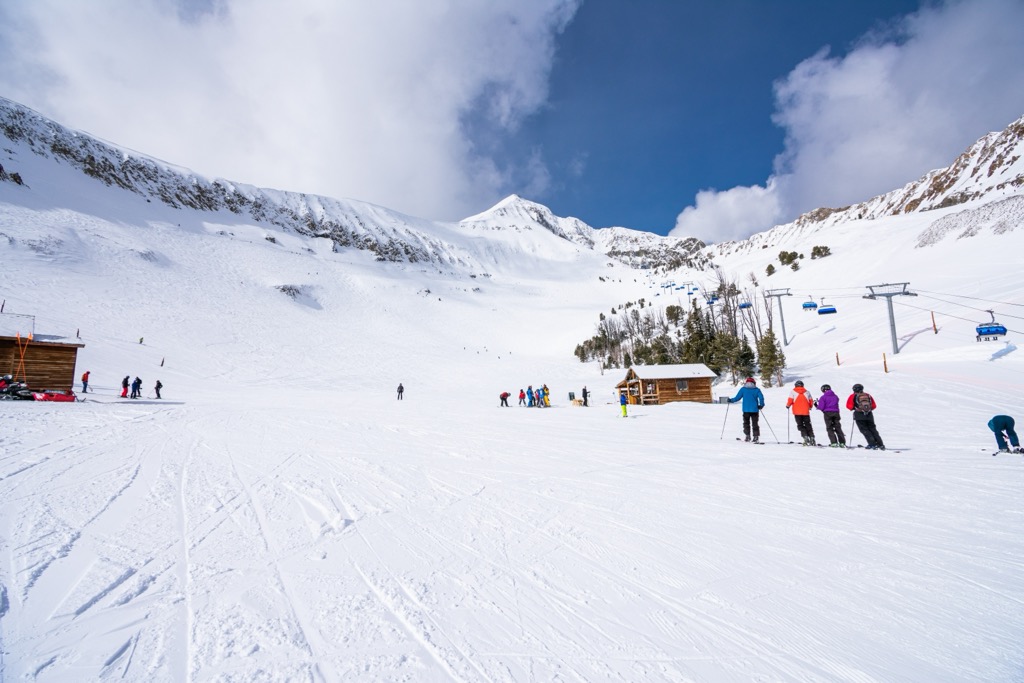
It’s hard to tell where Big Sky Resort stops, and the town of Big Sky starts. There are lodging and dining options all over the mountain. If you’re looking for a bite mid-day, the resort has got you covered for dining options. The hill has 22 resort-run eateries, coffee shops, bars, and food trucks.
Each base area (Spirit Mountain, Mountain Village, Moonlight Basin, and Madison Base) has restaurants. The Mountain Village has the most comprehensive array of options, from brick oven pizza to tacos to gourmet hot dogs to diner fare. Many restaurants will deliver as well.
Off the mountain are some great spots in the town of Big Sky. Alberto’s Mexican Cuisine, China Café, and Ousel and Spur Pizza Co. are all winners.
Regarding lodging, you’ve got options both on and off the mountain. Staying at the resort has its perks. Almost all of the resort-owned lodging around the resort is ski-in-ski-out. And if you book through the resort’s central booking, you can get a discount on lift tickets.
But there are also a ton of vacation rentals around the mountain, as well as VRBO rentals and AirBnBs. These all add up to an entire city’s worth of lodging for a transient population of ski tourists.
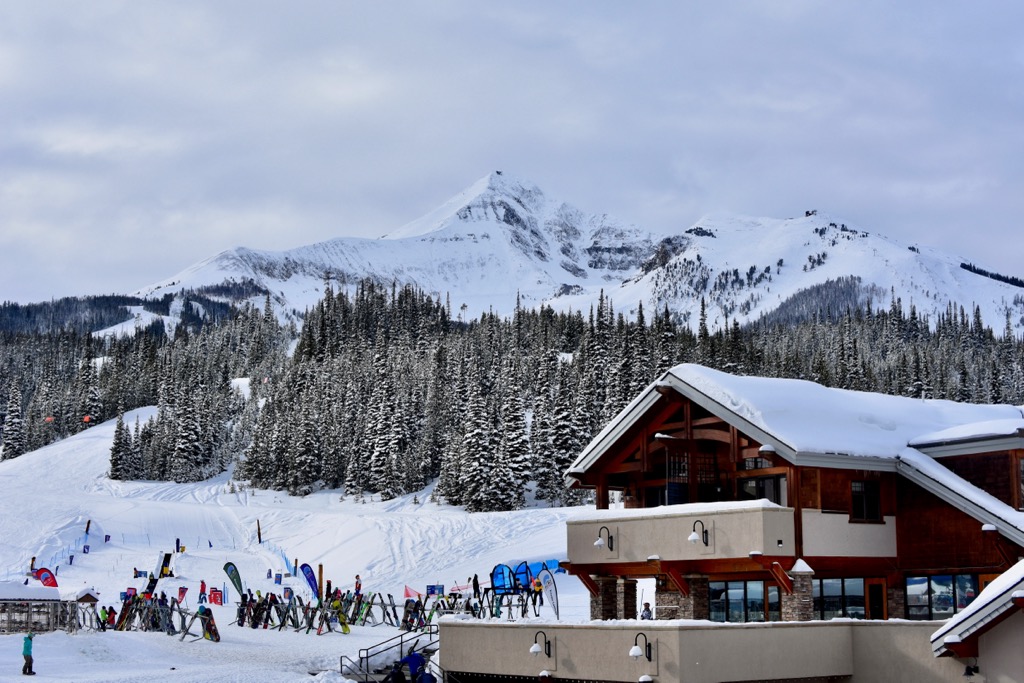
You can expect to pay at least $100 per person per night at the resort. Big Sky is a luxury resort with options to suit expensive tastes. Moonlight Basin is an excellent spot for even more high-end accommodation.
There is always some kind of live music event, ski movie showing, or aprés ski event in the mountain village. It’s a lively atmosphere, perfect for winding down after a long day on the slopes. The resort’s calendar is regularly updated with events.
If you’re lucky, you might visit the resort during a competition. Freestyle competitions and slalom races often happen at Big Sky, and they’re always entertaining.
As for après, there are almost as many options for drinks around Big Sky as there are for food. Check out Carabiner, Umbrella Bar, and Scissorbills Saloon at the mountain village, each featuring a swanky atmosphere and cocktails. The Moonlight Tavern in Moonlight Basin is another eatery/bar with an excellent lounge area.
Off the mountain, you’ll have more options. Just a few minutes away in the town of Big Sky, Broken Spoke, The Independent, and Beehive Brewery offer a mix of craft beer and drinks at more affordable prices than you’ll see at the resort. Pinky G’s is another prime spot, serving late-night pizza slices, beer, and cocktails.
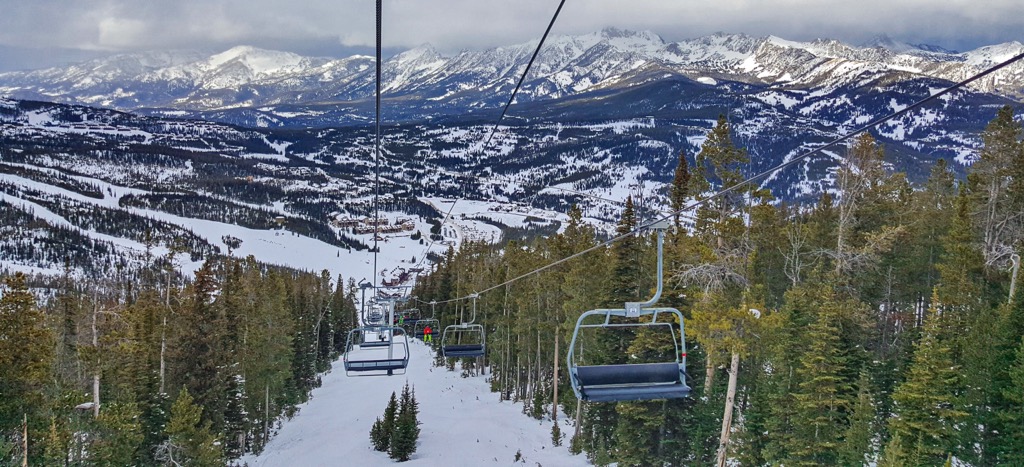
Outside of Big Sky, the nearest city is Bozeman, a half-hour drive to the northeast. Bozeman is another excellent college/ski town with its own vibe, local hotspots, lodging, and resorts.
Bridger Bowl is the closest resort to Bozeman in Custer Gallatin National Forest in the Bridger Range. The resort sits on the range's leeward (east face), running from summit to base, and includes technical terrain. It’s known for its large cliffs, long-running straight-line chutes, and fantastic terrain park. However, Bridger also features easy pistes on the lower part of the mountain and has a family-friendly vibe.
Another notable area near Big Sky is Yellowstone National Park, the world’s first National Park and the eighth largest in the United States. It features incredible geological formations like geysers and hot springs, a diverse cast of wildlife, and hundreds of mountains. Electric Peak, Mount Holmes, and Mount Sheridan are three of the most commonly hiked and skied peaks.
